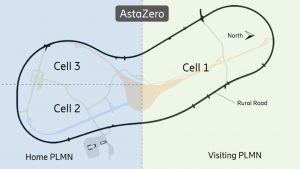Last modified more than a year ago

Keeping Vehicles Connected Across Borders
Connected vehicles are a part of everyday life of millions of drivers around the world. Drivers and passengers rely on networks to provide real-time information and in-car infotainment. When connecting vehicles, the most efficient, safe and economic alternative are cellular networks. 4G LTE networks already support today’s and future autonomous car services, 5G will provide real-time communication for more advanced and high demanding services. While cellular networks have wide coverage and are designed to manage rapidly moving users, issues still exist, especially when traveling across country borders. Leading Information and Communication Technology (ICT) service provider Ericsson teamed up with Daimler to test and demonstrate a way to overcome the issue and ensure service continuity, even at country borders.
Reduced cross-border delays
When connectivity is lost it is because the User Equipment (UE) connected devices need time to reconnect to a new network. In order to do this, the UE scans the spectrum to find a new network it can try to use and then needs to register to the new network. This is an issue because the loss of connectivity affects many use cases, causing voice sessions to be dropped. This has a severe impact on autonomous (self-driving) vehicles because vehicle manufacturers are liable for the vehicle. This means if connection to the central control equipment is lost, the vehicle may need to be taken out of self-driving mode or slow down.
Setting up borders (test)

Ericsson and Daimler ran tests on cross-border connectivity in an effort to reduce those cross-border delays. At the AstaZero test-site near Gothenburg, Sweden, they created a fictional country border by configuring a mobile network to emulate two different Mobile Network Operators (MNOs). Using Ericsson virtualisation techniques two mobile core networks were configured. A radio network configured to support the two mobile core networks with some radio cells (cell 2 and 3 in the illustration) belonging to one and some (cell 1) belonging to the other virtual network. Networks were then configured for different levels of roaming to measure the connection interruption. The steps to the experiment were as follows:
- Baseline scenario – a common basic type of roaming was configured where only the Home Subscriber Server (the database in the subscribers home network) is consulted to obtain user subscription data when a UE attempts to connect to a visiting mobile network. This normally results in several minutes of interruption and session breakdown since the new IP address needs to be allocated to the UE.
- Idle Mode Mobility – this involves the configuration of an additional roaming interface between Mobility Management Entities (MMEs) in the two networks to be able to trace back to previous connection and resume user plane activity. The two networks were configured to be equivalent so the UE knew it could use both. A Radio Access Network (RAN) feature called Release with Redirect was configured, which assists the UE in finding frequencies to use in the other network. This avoids that the spectrum needs to search for a network to use. The aforementioned scenario resulted in a loss of user plane connectivity for 1 second.
- Final step – the networks were configured to support complete handover (S1 Handover) of the user plane connection between the networks. This involved somewhat more configuration and coordination between networks since additional information about neighboring RAN nodes and radio cells are required. The scenario results in loss of user plane connectivity for around 0.1 seconds
Summary
The tests done by Ericcson and Daimler AG show that by activating and configuring some additional standard software features in the mobile network between MNOs, the interruption in connectivity could easily be reduced to approximately 1 second. This is believed to be sufficient for most use cases including C-ITS (Cooperative Intelligent Transport Systems) services. Furthermore, if additional effort to configure the networks for the Handover were also taken, the interruption was further decreased to 100 milliseconds – demonstrating that close to negligible interruptions are possible at border crossings. Read more about the test here.


